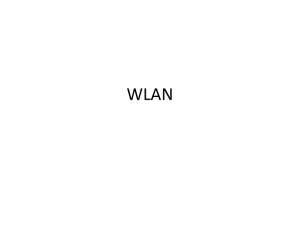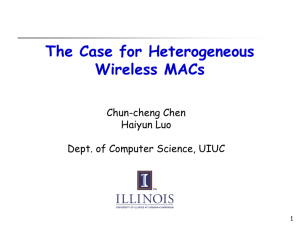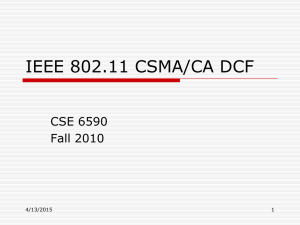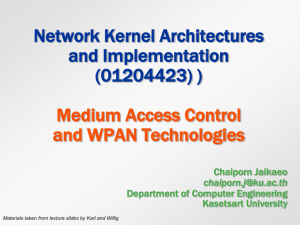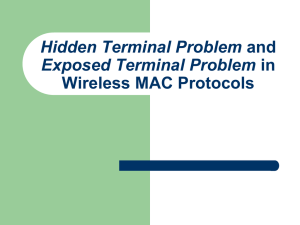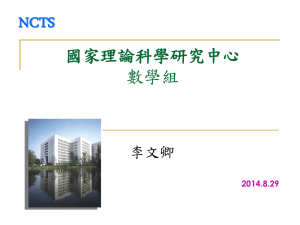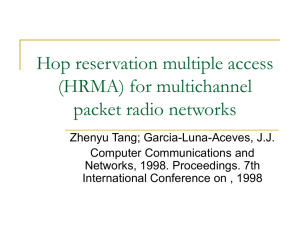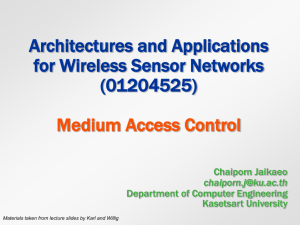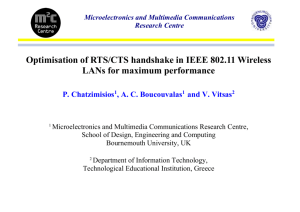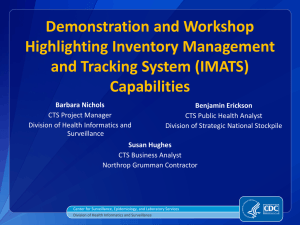How Effective is the IEEE 802.11 RTS/CTS Handshake in Ad Hoc
advertisement
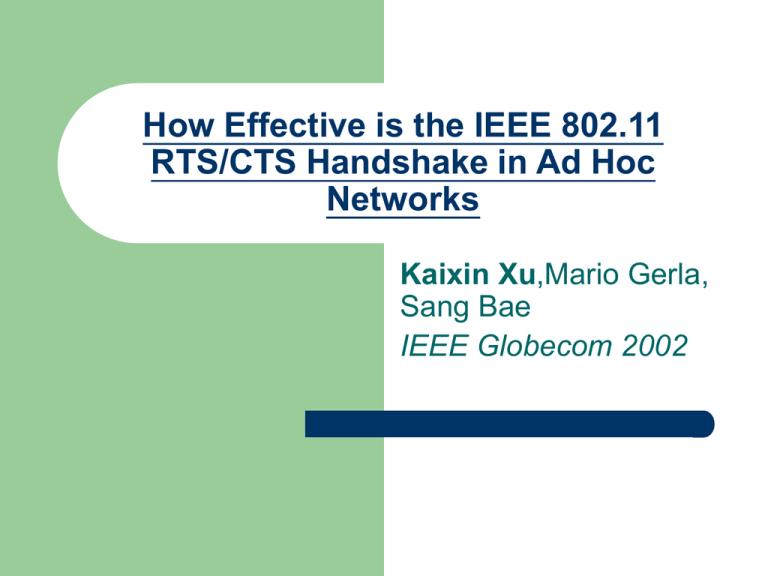
How Effective is the IEEE 802.11 RTS/CTS Handshake in Ad Hoc Networks Kaixin Xu,Mario Gerla, Sang Bae IEEE Globecom 2002 Outline INTRODUCTION EFFECTIVENESS OF RTS/CTS HANDSHAKE PROBLEM CAUSED BY LARGE INTERFERENCERANGE PROPOSED SCHEME AND SIMULATION EVALUATION CONCLUSION INTRODUCTION RTS/CTS handshake is mainly designed for resolving hidden terminal problem Such assumption may not hold when the transmitter-receiver distance exceeds a certain value reveals that large interference range is a serious problem EFFECTIVENESS OF RTS/CTS HANDSHAKE (1/7) three radio ranges: – – – Transmission Range (Rtx) represents the range within which a packet is successfully received Carrier Sensing Range (Rcs) is the range within which a transmitter triggers carrier sense detection. Interference Range (Ri) is the range within which stations in receive mode will be “interfered with” by an unrelated transmitter EFFECTIVENESS OF RTS/CTS HANDSHAKE (2/7) Investigation of the interference range – Ri= = (SNR_THRESHOLD is usually set to 10) Its relationship to the transmission range – Notations 當sender與 receiver的距離 大到一個程度 時,會造成Ri 大於Rtx,也就 是Ai大於 ARTS/CST EFFECTIVENESS OF RTS/CTS HANDSHAKE (3/7) Analysis (1) ERTS/CTS is equal to 1 (2)otherwise ERTS/CTS is smaller than 1 From equation (3) Ri then exceeds the Rtx EFFECTIVENESS OF RTS/CTS HANDSHAKE (4/7) Ai EFFECTIVENESS OF RTS/CTS HANDSHAKE (5/7) effectiveness many collisions may happen due to the large interference range and hidden terminal problem EFFECTIVENESS OF RTS/CTS HANDSHAKE (6/7) Influence of Physical Carrier Sensing EFFECTIVENESS OF RTS/CTS HANDSHAKE(7/7) conclusions of Physical Carrier Sensing – – – The interference range at a node is not fixed as the transmission range. RTS/CTS handshake is not sufficient effectiveness Big carrier sensing range is not desired due to hardware limitations and significant throughput reduction PROPOSED SCHEME--Conservative CTS Reply (CCR) main idea – – a node only replies a CTS packet for a RTS quest when receiving power of that RTS packet is larger than a certain threshold (CTS-REPLY-THRESHOLD), even if the RTS packet is received successfully and this node is idle. Pr0.56 – use it as the CTS-REPLY-THRESHOLD Only replies CTS packets to those nodes which are at most 0.56*Rtx meters away our scheme actually reduces the effective transmission range to resolve the interference PROPOSED SCHEME--Conservative CTS Reply (CCR) inconsistency between broadcasting and unicasting – – – broadcast packets are not protected by RTS/CTS most routing protocols in MANETs use broadcast for route discovery routing protocols will discover a link which may be disabled by our scheme To solve this problem and maintain consistency – a node to drop broadcast packets if the receiving power of that packet is below CTS-REPLY-THRESHOLD PROBLEM CAUSED BY LARGE INTERFERENCERANGE(1/7) [4] J. Li, C. Blake, D. Couto, H. Lee, and R. Morris, “Capacity of Ad Hoc Wireless Networks,” ACM MobiCom 2001 – – – NS2 simulator transmission range: 250m interference range: 550m 200m not considering the large interference range node 2 and node 3 can not transmit at the same time. capacity is reduced to 1/3 PROBLEM CAUSED BY LARGE INTERFERENCERANGE(2/7) IEEE 802.11 MAC cannot achieve this bandwidth since a lot of bandwidth will be wasted due to collisions 200m considering the large interference range node 2, 3, 4 can not transmit at the same time. capacity is reduced to 1/4 PROBLEM CAUSED BY LARGE INTERFERENCERANGE(3/7) To further demonstrate the performance degradation due to large interference range – – – QualNet simulator wireless radio is 367m channel bandwidth: 2Mbps 300m 300m PROBLEM CAUSED BY LARGE INTERFERENCERANGE(4/7) node 4 is out of the TX and in the Ri PROBLEM CAUSED BY LARGE INTERFERENCERANGE(5/7) PROBLEM CAUSED BY LARGE INTERFERENCERANGE(6/7) PROBLEM CAUSED BY LARGE INTERFERENCERANGE(7/7) SIMULATION EVALUATION(1/3) Simulation Platform – – – – – QualNetTM simulator incorporates a detailed and accurate model of the physical channel and of the IEEE 802.11 MAC layer parameters of QualNet are following the IEEE 802.11 standard and Lucent WaveLAN wireless card transmission range: 367m carrier sensing range : 670m SIMULATION EVALUATION(2/3) Simulation Evaluation – – – – – – 100 nodes 1500mX1500m Channel bandwidth is 2Mbps The CBR data packet size: 1024 byte packet rate is 10pps routing algorithm: DSDV SIMULATION EVALUATION(3/3) CONCLUSION First – – Second – frequent data packet corruptions due to interference range are verified through simulation Third – we analyze the interference range Ri The effectiveness of RTS/CTS handshake is also explored in theory a simple MAC layer scheme is proposed to combat the large interference range. Main advantage – our proposed scheme is that it is simple and only has a trivial modification to IEEE 802.11 standard

